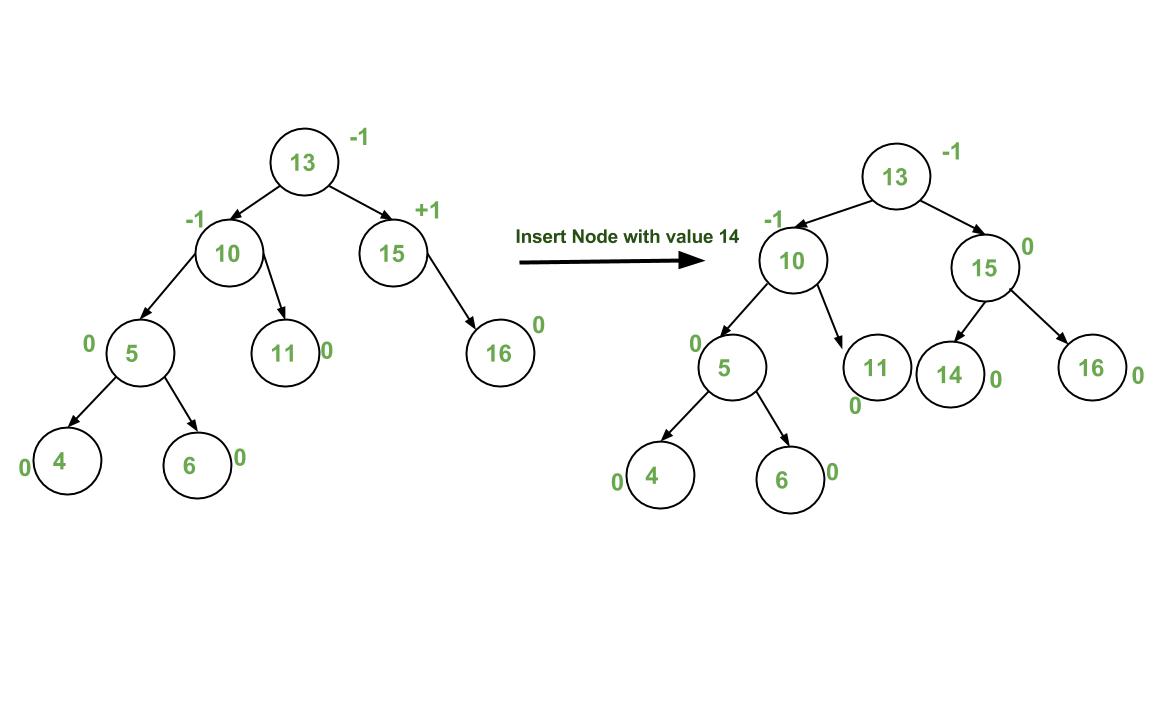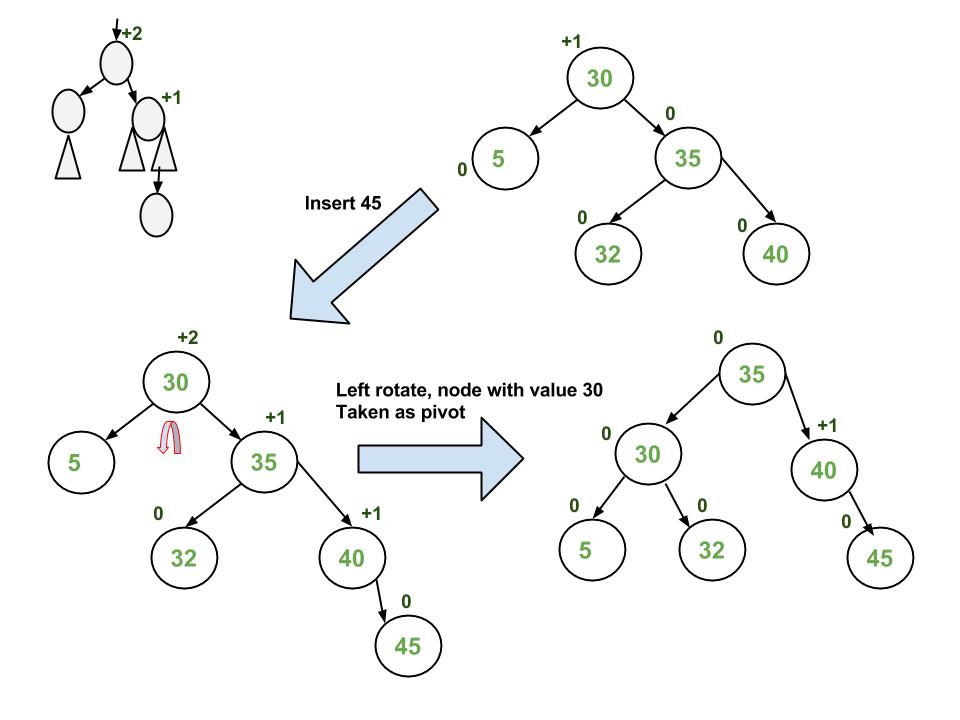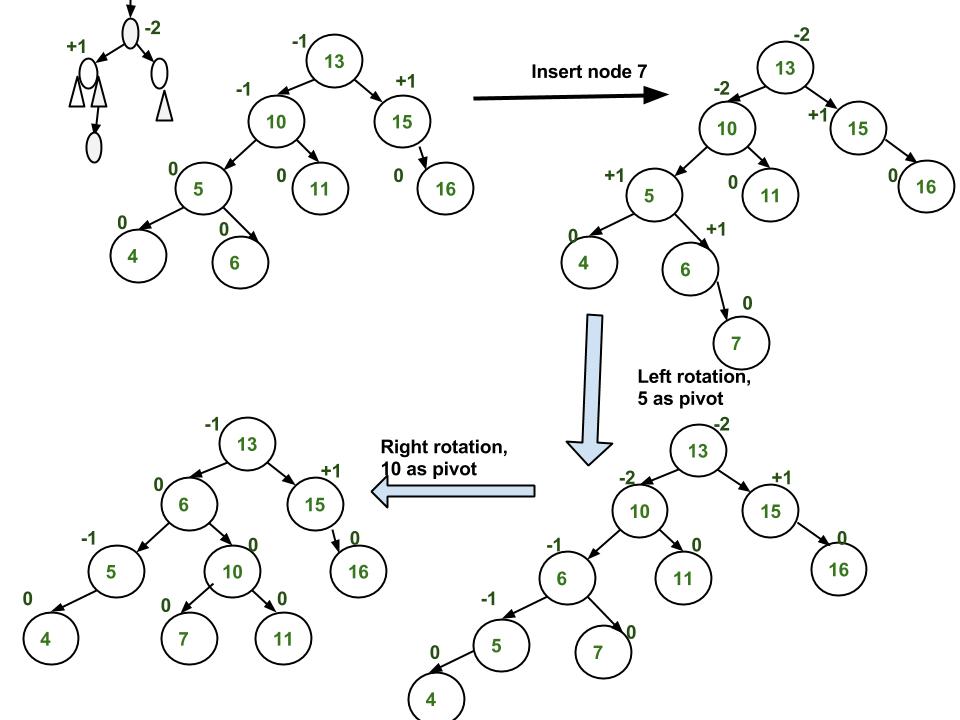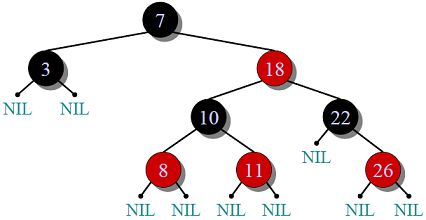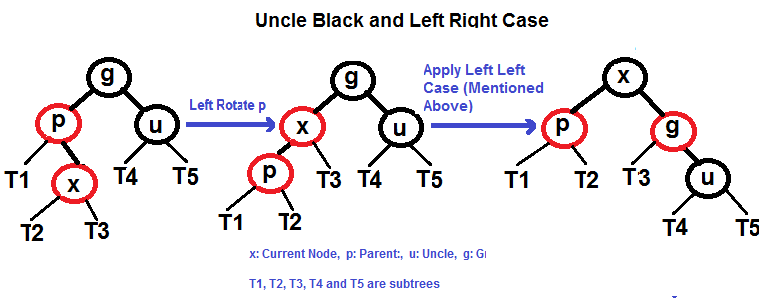AVL Tree

The above tree is AVL because differences between heights of left and right subtrees for every node is less than or equal to 1.
An Example Tree that is NOT an AVL Tree
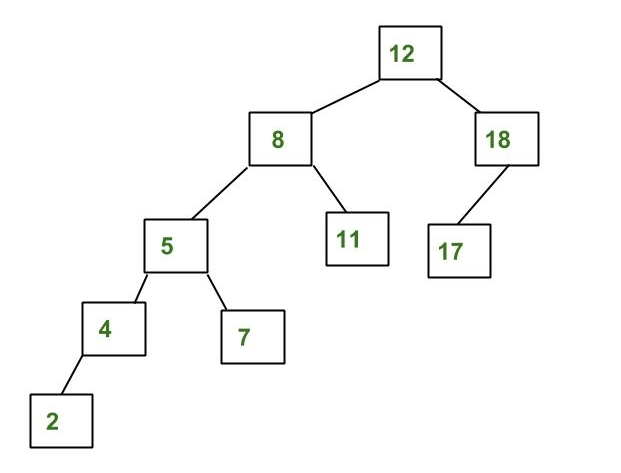
The above tree is not AVL because differences between heights of left and right subtrees for 8 and 18 is greater than 1.
Why AVL Trees?
Most of the BST operations (e.g., search, max, min, insert, delete.. etc) take O(h) time where h is the height of the BST. The cost of these operations may become O(n) for a skewed Binary tree. If we make sure that height of the tree remains O(Logn) after every insertion and deletion, then we can guarantee an upper bound of O(Logn) for all these operations. The height of an AVL tree is always O(Logn) where n is the number of nodes in the tree (See this video lecture for proof).
Insertion
To make sure that the given tree remains AVL after every insertion, we must augment the standard BST insert operation to perform some re-balancing. Following are two basic operations that can be performed to re-balance a BST without violating the BST property (keys(left) < key(root) < keys(right)).
1) Left Rotation
2) Right Rotation
T1, T2 and T3 are subtrees of the tree
rooted with y (on the left side) or x (on
the right side)
y x
/ \ Right Rotation / \
x T3 - - - - - - - > T1 y
/ \ < - - - - - - - / \
T1 T2 Left Rotation T2 T3
Keys in both of the above trees follow the
following order
keys(T1) < key(x) < keys(T2) < key(y) < keys(T3)
So BST property is not violated anywhere.
Steps to follow for insertion
Let the newly inserted node be w
1) Perform standard BST insert for w.
2) Starting from w, travel up and find the first unbalanced node. Let z be the first unbalanced node, y be the child of z that comes on the path from w to z and x be the grandchild of z that comes on the path from w to z.
3) Re-balance the tree by performing appropriate rotations on the subtree rooted with z. There can be 4 possible cases that needs to be handled as x, y and z can be arranged in 4 ways. Following are the possible 4 arrangements:
a) y is left child of z and x is left child of y (Left Left Case)
b) y is left child of z and x is right child of y (Left Right Case)
c) y is right child of z and x is right child of y (Right Right Case)
d) y is right child of z and x is left child of y (Right Left Case)
Following are the operations to be performed in above mentioned 4 cases. In all of the cases, we only need to re-balance the subtree rooted with z and the complete tree becomes balanced as the height of subtree (After appropriate rotations) rooted with z becomes same as it was before insertion. (See this video lecture for proof)
a) Left Left Case
T1, T2, T3 and T4 are subtrees.
z y
/ \ / \
y T4 Right Rotate (z) x z
/ \ - - - - - - - - -> / \ / \
x T3 T1 T2 T3 T4
/ \
T1 T2
b) Left Right Case
z z x
/ \ / \ / \
y T4 Left Rotate (y) x T4 Right Rotate(z) y z
/ \ - - - - - - - - -> / \ - - - - - - - -> / \ / \
T1 x y T3 T1 T2 T3 T4
/ \ / \
T2 T3 T1 T2
c) Right Right Case
z y
/ \ / \
T1 y Left Rotate(z) z x
/ \ - - - - - - - -> / \ / \
T2 x T1 T2 T3 T4
/ \
T3 T4
d) Right Left Case
z z x
/ \ / \ / \
T1 y Right Rotate (y) T1 x Left Rotate(z) z y
/ \ - - - - - - - - -> / \ - - - - - - - -> / \ / \
x T4 T2 y T1 T2 T3 T4
/ \ / \
T2 T3 T3 T4
AVL tree is a self-balancing Binary Search Tree (BST) where the difference between heights of left and right subtrees cannot be more than one for all nodes.
An Example Tree that is an AVL Tree

The above tree is AVL because differences between heights of left and right subtrees for every node is less than or equal to 1.

The above tree is AVL because differences between heights of left and right subtrees for every node is less than or equal to 1.
An Example Tree that is NOT an AVL Tree

The above tree is not AVL because differences between heights of left and right subtrees for 8 and 18 is greater than 1.

The above tree is not AVL because differences between heights of left and right subtrees for 8 and 18 is greater than 1.
Why AVL Trees?
Most of the BST operations (e.g., search, max, min, insert, delete.. etc) take O(h) time where h is the height of the BST. The cost of these operations may become O(n) for a skewed Binary tree. If we make sure that height of the tree remains O(Logn) after every insertion and deletion, then we can guarantee an upper bound of O(Logn) for all these operations. The height of an AVL tree is always O(Logn) where n is the number of nodes in the tree (See this video lecture for proof).
Most of the BST operations (e.g., search, max, min, insert, delete.. etc) take O(h) time where h is the height of the BST. The cost of these operations may become O(n) for a skewed Binary tree. If we make sure that height of the tree remains O(Logn) after every insertion and deletion, then we can guarantee an upper bound of O(Logn) for all these operations. The height of an AVL tree is always O(Logn) where n is the number of nodes in the tree (See this video lecture for proof).
Insertion
To make sure that the given tree remains AVL after every insertion, we must augment the standard BST insert operation to perform some re-balancing. Following are two basic operations that can be performed to re-balance a BST without violating the BST property (keys(left) < key(root) < keys(right)).
1) Left Rotation
2) Right Rotation
To make sure that the given tree remains AVL after every insertion, we must augment the standard BST insert operation to perform some re-balancing. Following are two basic operations that can be performed to re-balance a BST without violating the BST property (keys(left) < key(root) < keys(right)).
1) Left Rotation
2) Right Rotation
T1, T2 and T3 are subtrees of the tree
rooted with y (on the left side) or x (on
the right side)
y x
/ \ Right Rotation / \
x T3 - - - - - - - > T1 y
/ \ < - - - - - - - / \
T1 T2 Left Rotation T2 T3
Keys in both of the above trees follow the
following order
keys(T1) < key(x) < keys(T2) < key(y) < keys(T3)
So BST property is not violated anywhere.
Steps to follow for insertion
Let the newly inserted node be w
1) Perform standard BST insert for w.
2) Starting from w, travel up and find the first unbalanced node. Let z be the first unbalanced node, y be the child of z that comes on the path from w to z and x be the grandchild of z that comes on the path from w to z.
3) Re-balance the tree by performing appropriate rotations on the subtree rooted with z. There can be 4 possible cases that needs to be handled as x, y and z can be arranged in 4 ways. Following are the possible 4 arrangements:
a) y is left child of z and x is left child of y (Left Left Case)
b) y is left child of z and x is right child of y (Left Right Case)
c) y is right child of z and x is right child of y (Right Right Case)
d) y is right child of z and x is left child of y (Right Left Case)
Let the newly inserted node be w
1) Perform standard BST insert for w.
2) Starting from w, travel up and find the first unbalanced node. Let z be the first unbalanced node, y be the child of z that comes on the path from w to z and x be the grandchild of z that comes on the path from w to z.
3) Re-balance the tree by performing appropriate rotations on the subtree rooted with z. There can be 4 possible cases that needs to be handled as x, y and z can be arranged in 4 ways. Following are the possible 4 arrangements:
a) y is left child of z and x is left child of y (Left Left Case)
b) y is left child of z and x is right child of y (Left Right Case)
c) y is right child of z and x is right child of y (Right Right Case)
d) y is right child of z and x is left child of y (Right Left Case)
Following are the operations to be performed in above mentioned 4 cases. In all of the cases, we only need to re-balance the subtree rooted with z and the complete tree becomes balanced as the height of subtree (After appropriate rotations) rooted with z becomes same as it was before insertion. (See this video lecture for proof)
a) Left Left Case
T1, T2, T3 and T4 are subtrees.
z y
/ \ / \
y T4 Right Rotate (z) x z
/ \ - - - - - - - - -> / \ / \
x T3 T1 T2 T3 T4
/ \
T1 T2
b) Left Right Case
z z x
/ \ / \ / \
y T4 Left Rotate (y) x T4 Right Rotate(z) y z
/ \ - - - - - - - - -> / \ - - - - - - - -> / \ / \
T1 x y T3 T1 T2 T3 T4
/ \ / \
T2 T3 T1 T2
c) Right Right Case
z y
/ \ / \
T1 y Left Rotate(z) z x
/ \ - - - - - - - -> / \ / \
T2 x T1 T2 T3 T4
/ \
T3 T4
d) Right Left Case
z z x
/ \ / \ / \
T1 y Right Rotate (y) T1 x Left Rotate(z) z y
/ \ - - - - - - - - -> / \ - - - - - - - -> / \ / \
x T4 T2 y T1 T2 T3 T4
/ \ / \
T2 T3 T3 T4
Steps to follow for deletion.
To make sure that the given tree remains AVL after every deletion, we must augment the standard BST delete operation to perform some re-balancing. Following are two basic operations that can be performed to re-balance a BST without violating the BST property (keys(left) < key(root) < keys(right)).
1) Left Rotation
2) Right Rotation
T1, T2 and T3 are subtrees of the tree rooted with y (on left side)
or x (on right side)
y x
/ \ Right Rotation / \
x T3 – - – - – - – > T1 y
/ \ < - - - - - - - / \
T1 T2 Left Rotation T2 T3
Keys in both of the above trees follow the following order
keys(T1) < key(x) < keys(T2) < key(y) < keys(T3)
So BST property is not violated anywhere.
Let w be the node to be deleted
1) Perform standard BST delete for w.
2) Starting from w, travel up and find the first unbalanced node. Let z be the first unbalanced node, y be the larger height child of z, and x be the larger height child of y. Note that the definitions of x and y are different from insertion here.
3) Re-balance the tree by performing appropriate rotations on the subtree rooted with z. There can be 4 possible cases that needs to be handled as x, y and z can be arranged in 4 ways. Following are the possible 4 arrangements:
a) y is left child of z and x is left child of y (Left Left Case)
b) y is left child of z and x is right child of y (Left Right Case)
c) y is right child of z and x is right child of y (Right Right Case)
d) y is right child of z and x is left child of y (Right Left Case)
Like insertion, following are the operations to be performed in above mentioned 4 cases. Note that, unlike insertion, fixing the node z won’t fix the complete AVL tree. After fixing z, we may have to fix ancestors of z as well (See this video lecture for proof)
a) Left Left Case
T1, T2, T3 and T4 are subtrees.
z y
/ \ / \
y T4 Right Rotate (z) x z
/ \ - - - - - - - - -> / \ / \
x T3 T1 T2 T3 T4
/ \
T1 T2
b) Left Right Case
z z x
/ \ / \ / \
y T4 Left Rotate (y) x T4 Right Rotate(z) y z
/ \ - - - - - - - - -> / \ - - - - - - - -> / \ / \
T1 x y T3 T1 T2 T3 T4
/ \ / \
T2 T3 T1 T2
c) Right Right Case
z y
/ \ / \
T1 y Left Rotate(z) z x
/ \ - - - - - - - -> / \ / \
T2 x T1 T2 T3 T4
/ \
T3 T4
d) Right Left Case
z z x
/ \ / \ / \
T1 y Right Rotate (y) T1 x Left Rotate(z) z y
/ \ - - - - - - - - -> / \ - - - - - - - -> / \ / \
x T4 T2 y T1 T2 T3 T4
/ \ / \
T2 T3 T3 T4
Unlike insertion, in deletion, after we perform a rotation at z, we may have to perform a rotation at ancestors of z. Thus, we must continue to trace the path until we reach the root.
Example:
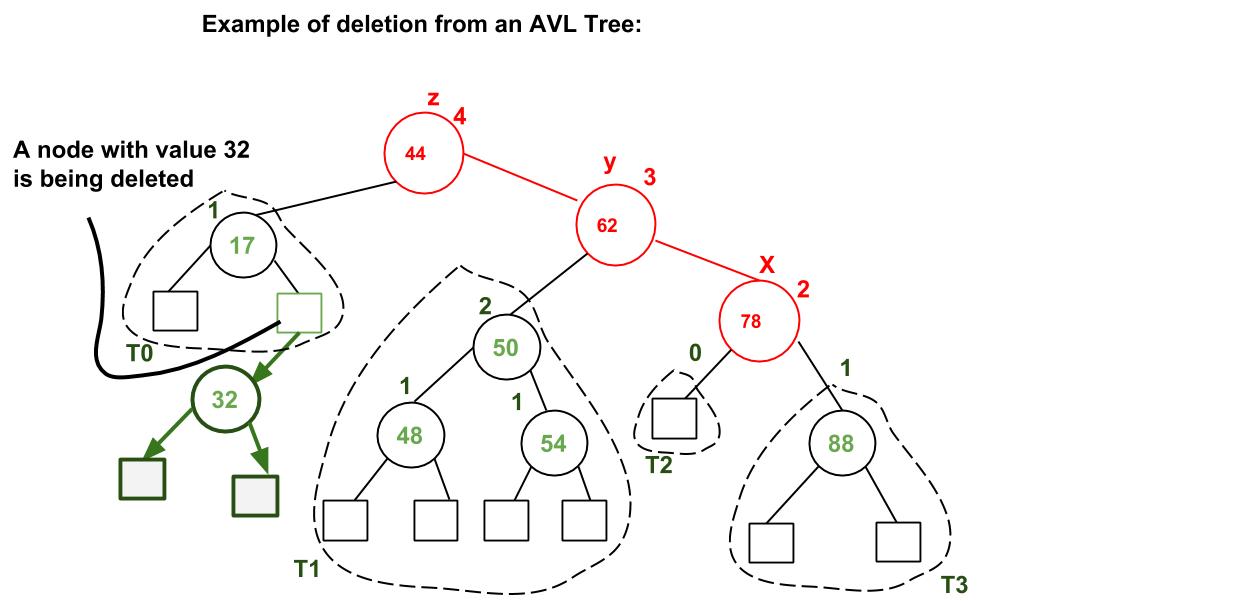
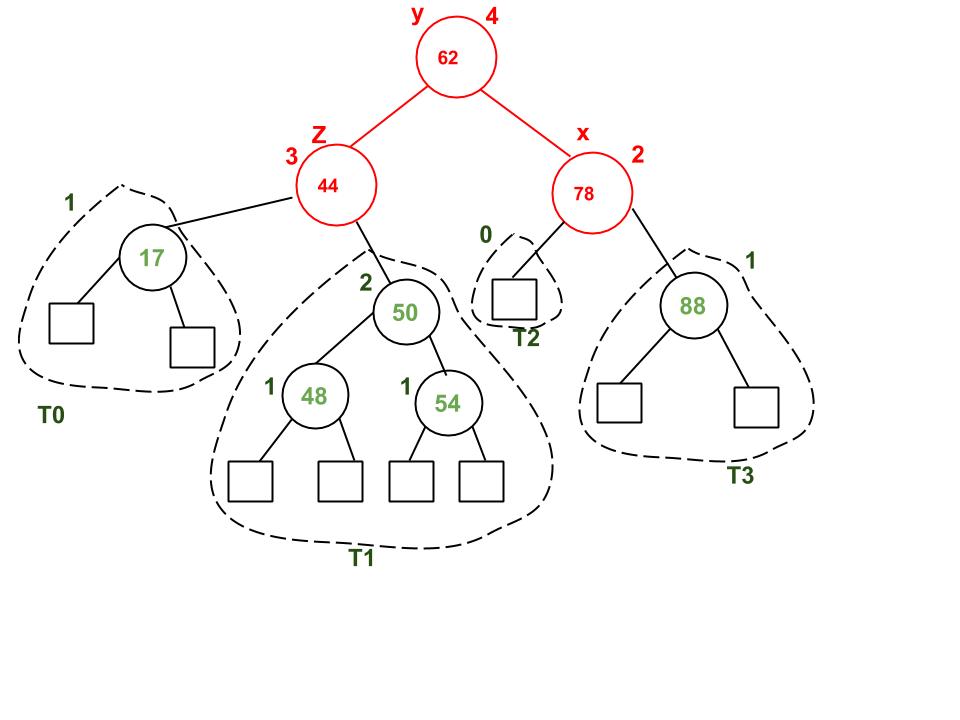 A node with value 32 is being deleted. After deleting 32, we travel up and find the first unbalanaced node which is 44. We mark it as z, its higher height child as y which is 62, and y’s higher height child as x which could be either 78 or 50 as both are of same height. We have considered 78. Now the case is Right Right, so we perform left rotation.
A node with value 32 is being deleted. After deleting 32, we travel up and find the first unbalanaced node which is 44. We mark it as z, its higher height child as y which is 62, and y’s higher height child as x which could be either 78 or 50 as both are of same height. We have considered 78. Now the case is Right Right, so we perform left rotation.
Steps to follow for deletion.
To make sure that the given tree remains AVL after every deletion, we must augment the standard BST delete operation to perform some re-balancing. Following are two basic operations that can be performed to re-balance a BST without violating the BST property (keys(left) < key(root) < keys(right)).
1) Left Rotation
2) Right Rotation
To make sure that the given tree remains AVL after every deletion, we must augment the standard BST delete operation to perform some re-balancing. Following are two basic operations that can be performed to re-balance a BST without violating the BST property (keys(left) < key(root) < keys(right)).
1) Left Rotation
2) Right Rotation
T1, T2 and T3 are subtrees of the tree rooted with y (on left side)
or x (on right side)
y x
/ \ Right Rotation / \
x T3 – - – - – - – > T1 y
/ \ < - - - - - - - / \
T1 T2 Left Rotation T2 T3
Keys in both of the above trees follow the following order
keys(T1) < key(x) < keys(T2) < key(y) < keys(T3)
So BST property is not violated anywhere.
Let w be the node to be deleted
1) Perform standard BST delete for w.
2) Starting from w, travel up and find the first unbalanced node. Let z be the first unbalanced node, y be the larger height child of z, and x be the larger height child of y. Note that the definitions of x and y are different from insertion here.
3) Re-balance the tree by performing appropriate rotations on the subtree rooted with z. There can be 4 possible cases that needs to be handled as x, y and z can be arranged in 4 ways. Following are the possible 4 arrangements:
a) y is left child of z and x is left child of y (Left Left Case)
b) y is left child of z and x is right child of y (Left Right Case)
c) y is right child of z and x is right child of y (Right Right Case)
d) y is right child of z and x is left child of y (Right Left Case)
1) Perform standard BST delete for w.
2) Starting from w, travel up and find the first unbalanced node. Let z be the first unbalanced node, y be the larger height child of z, and x be the larger height child of y. Note that the definitions of x and y are different from insertion here.
3) Re-balance the tree by performing appropriate rotations on the subtree rooted with z. There can be 4 possible cases that needs to be handled as x, y and z can be arranged in 4 ways. Following are the possible 4 arrangements:
a) y is left child of z and x is left child of y (Left Left Case)
b) y is left child of z and x is right child of y (Left Right Case)
c) y is right child of z and x is right child of y (Right Right Case)
d) y is right child of z and x is left child of y (Right Left Case)
Like insertion, following are the operations to be performed in above mentioned 4 cases. Note that, unlike insertion, fixing the node z won’t fix the complete AVL tree. After fixing z, we may have to fix ancestors of z as well (See this video lecture for proof)
a) Left Left Case
T1, T2, T3 and T4 are subtrees.
z y
/ \ / \
y T4 Right Rotate (z) x z
/ \ - - - - - - - - -> / \ / \
x T3 T1 T2 T3 T4
/ \
T1 T2
b) Left Right Case
z z x
/ \ / \ / \
y T4 Left Rotate (y) x T4 Right Rotate(z) y z
/ \ - - - - - - - - -> / \ - - - - - - - -> / \ / \
T1 x y T3 T1 T2 T3 T4
/ \ / \
T2 T3 T1 T2
c) Right Right Case
z y
/ \ / \
T1 y Left Rotate(z) z x
/ \ - - - - - - - -> / \ / \
T2 x T1 T2 T3 T4
/ \
T3 T4
d) Right Left Case
z z x
/ \ / \ / \
T1 y Right Rotate (y) T1 x Left Rotate(z) z y
/ \ - - - - - - - - -> / \ - - - - - - - -> / \ / \
x T4 T2 y T1 T2 T3 T4
/ \ / \
T2 T3 T3 T4
Unlike insertion, in deletion, after we perform a rotation at z, we may have to perform a rotation at ancestors of z. Thus, we must continue to trace the path until we reach the root.
Example:



A node with value 32 is being deleted. After deleting 32, we travel up and find the first unbalanaced node which is 44. We mark it as z, its higher height child as y which is 62, and y’s higher height child as x which could be either 78 or 50 as both are of same height. We have considered 78. Now the case is Right Right, so we perform left rotation.
C implementation
Following is the C implementation for AVL Tree. The following C implementation uses the recursive BST delete as basis. In the recursive BST delete, after deletion, we get pointers to all ancestors one by one in bottom up manner. So we don’t need parent pointer to travel up. The recursive code itself travels up and visits all the ancestors of the deleted node.
1) Perform the normal BST insertion and deletion.
2) The current node must be one of the ancestors of the deleted node. Update the height of the current node.
3) Get the balance factor (left subtree height – right subtree height) of the current node.
4) If balance factor is greater than 1, then the current node is unbalanced and we are either in Left Left case or Left Right case. To check whether it is Left Left case or Left Right case, get the balance factor of left subtree. If balance factor of the left subtree is greater than or equal to 0, then it is Left Left case, else Left Right case.
5) If balance factor is less than -1, then the current node is unbalanced and we are either in Right Right case or Right Left case. To check whether it is Right Right case or Right Left case, get the balance factor of right subtree. If the balance factor of the right subtree is smaller than or equal to 0, then it is Right Right case, else Right Left case.
Output:
Preorder traversal of the constructed AVL tree is
9 1 0 -1 5 2 6 10 11
Preorder traversal after deletion of 10
1 0 -1 9 5 2 6 11
Time Complexity: The rotation operations (left and right rotate) take constant time as only a few pointers are being changed there. Updating the height and getting the balance factor also takes constant time. So the time complexity of AVL insert remains same as BST insert which is O(h) where h is the height of the tree. Since AVL tree is balanced, the height is O(Logn). So time complexity of AVL insert is O(Logn).
C implementation
Following is the C implementation for AVL Tree. The following C implementation uses the recursive BST delete as basis. In the recursive BST delete, after deletion, we get pointers to all ancestors one by one in bottom up manner. So we don’t need parent pointer to travel up. The recursive code itself travels up and visits all the ancestors of the deleted node.
1) Perform the normal BST insertion and deletion.
2) The current node must be one of the ancestors of the deleted node. Update the height of the current node.
3) Get the balance factor (left subtree height – right subtree height) of the current node.
4) If balance factor is greater than 1, then the current node is unbalanced and we are either in Left Left case or Left Right case. To check whether it is Left Left case or Left Right case, get the balance factor of left subtree. If balance factor of the left subtree is greater than or equal to 0, then it is Left Left case, else Left Right case.
5) If balance factor is less than -1, then the current node is unbalanced and we are either in Right Right case or Right Left case. To check whether it is Right Right case or Right Left case, get the balance factor of right subtree. If the balance factor of the right subtree is smaller than or equal to 0, then it is Right Right case, else Right Left case.
Following is the C implementation for AVL Tree. The following C implementation uses the recursive BST delete as basis. In the recursive BST delete, after deletion, we get pointers to all ancestors one by one in bottom up manner. So we don’t need parent pointer to travel up. The recursive code itself travels up and visits all the ancestors of the deleted node.
1) Perform the normal BST insertion and deletion.
2) The current node must be one of the ancestors of the deleted node. Update the height of the current node.
3) Get the balance factor (left subtree height – right subtree height) of the current node.
4) If balance factor is greater than 1, then the current node is unbalanced and we are either in Left Left case or Left Right case. To check whether it is Left Left case or Left Right case, get the balance factor of left subtree. If balance factor of the left subtree is greater than or equal to 0, then it is Left Left case, else Left Right case.
5) If balance factor is less than -1, then the current node is unbalanced and we are either in Right Right case or Right Left case. To check whether it is Right Right case or Right Left case, get the balance factor of right subtree. If the balance factor of the right subtree is smaller than or equal to 0, then it is Right Right case, else Right Left case.
Output:
Preorder traversal of the constructed AVL tree is 9 1 0 -1 5 2 6 10 11 Preorder traversal after deletion of 10 1 0 -1 9 5 2 6 11
Time Complexity: The rotation operations (left and right rotate) take constant time as only a few pointers are being changed there. Updating the height and getting the balance factor also takes constant time. So the time complexity of AVL insert remains same as BST insert which is O(h) where h is the height of the tree. Since AVL tree is balanced, the height is O(Logn). So time complexity of AVL insert is O(Logn).
B-Tree
B-Tree is a self-balancing search tree. In most of the other self-balancing search trees (like AVL and Red-Black Trees), it is assumed that everything is in main memory. To understand the use of B-Trees, we must think of the huge amount of data that cannot fit in main memory. When the number of keys is high, the data is read from disk in the form of blocks. Disk access time is very high compared to main memory access time. The main idea of using B-Trees is to reduce the number of disk accesses. Most of the tree operations (search, insert, delete, max, min, ..etc ) require O(h) disk accesses where h is the height of the tree. B-tree is a fat tree. The height of B-Trees is kept low by putting maximum possible keys in a B-Tree node. Generally, a B-Tree node size is kept equal to the disk block size. Since h is low for B-Tree, total disk accesses for most of the operations are reduced significantly compared to balanced Binary Search Trees like AVL Tree, Red-Black Tree, ..etc.
Properties of B-Tree
1) All leaves are at same level.
2) A B-Tree is defined by the term minimum degree ‘t’. The value of t depends upon disk block size.
3) Every node except root must contain at least t-1 keys. Root may contain minimum 1 key.
4) All nodes (including root) may contain at most 2t – 1 keys.
5) Number of children of a node is equal to the number of keys in it plus 1.
6) All keys of a node are sorted in increasing order. The child between two keys k1 and k2 contains all keys in the range from k1 and k2.
7) B-Tree grows and shrinks from the root which is unlike Binary Search Tree. Binary Search Trees grow downward and also shrink from downward.
8) Like other balanced Binary Search Trees, time complexity to search, insert and delete is O(Logn).
Following is an example B-Tree of minimum degree 3. Note that in practical B-Trees, the value of minimum degree is much more than 3.

Search
Search is similar to the search in Binary Search Tree. Let the key to be searched be k. We start from the root and recursively traverse down. For every visited non-leaf node, if the node has the key, we simply return the node. Otherwise, we recur down to the appropriate child (The child which is just before the first greater key) of the node. If we reach a leaf node and don’t find k in the leaf node, we return NULL.
Traverse
Traversal is also similar to Inorder traversal of Binary Tree. We start from the leftmost child, recursively print the leftmost child, then repeat the same process for remaining children and keys. In the end, recursively print the rightmost child.
Insert Operation
Since B Tree is a self-balancing tree, you cannot force insert a key into just any node.
The following algorithm applies:
1. Run the search operation and find the appropriate place of insertion.
2. Insert the new key at the proper location, but if the node has a maximum number of keys already:
a. The node, along with a newly inserted key, will split from the middle element.
b. The middle element will become the parent for the other two child nodes.
c. The nodes must re-arrange keys in ascending order.
B-Tree is a self-balancing search tree. In most of the other self-balancing search trees (like AVL and Red-Black Trees), it is assumed that everything is in main memory. To understand the use of B-Trees, we must think of the huge amount of data that cannot fit in main memory. When the number of keys is high, the data is read from disk in the form of blocks. Disk access time is very high compared to main memory access time. The main idea of using B-Trees is to reduce the number of disk accesses. Most of the tree operations (search, insert, delete, max, min, ..etc ) require O(h) disk accesses where h is the height of the tree. B-tree is a fat tree. The height of B-Trees is kept low by putting maximum possible keys in a B-Tree node. Generally, a B-Tree node size is kept equal to the disk block size. Since h is low for B-Tree, total disk accesses for most of the operations are reduced significantly compared to balanced Binary Search Trees like AVL Tree, Red-Black Tree, ..etc.
Properties of B-Tree
1) All leaves are at same level.
2) A B-Tree is defined by the term minimum degree ‘t’. The value of t depends upon disk block size.
3) Every node except root must contain at least t-1 keys. Root may contain minimum 1 key.
4) All nodes (including root) may contain at most 2t – 1 keys.
5) Number of children of a node is equal to the number of keys in it plus 1.
6) All keys of a node are sorted in increasing order. The child between two keys k1 and k2 contains all keys in the range from k1 and k2.
7) B-Tree grows and shrinks from the root which is unlike Binary Search Tree. Binary Search Trees grow downward and also shrink from downward.
8) Like other balanced Binary Search Trees, time complexity to search, insert and delete is O(Logn).
1) All leaves are at same level.
2) A B-Tree is defined by the term minimum degree ‘t’. The value of t depends upon disk block size.
3) Every node except root must contain at least t-1 keys. Root may contain minimum 1 key.
4) All nodes (including root) may contain at most 2t – 1 keys.
5) Number of children of a node is equal to the number of keys in it plus 1.
6) All keys of a node are sorted in increasing order. The child between two keys k1 and k2 contains all keys in the range from k1 and k2.
7) B-Tree grows and shrinks from the root which is unlike Binary Search Tree. Binary Search Trees grow downward and also shrink from downward.
8) Like other balanced Binary Search Trees, time complexity to search, insert and delete is O(Logn).
Following is an example B-Tree of minimum degree 3. Note that in practical B-Trees, the value of minimum degree is much more than 3.


Search
Search is similar to the search in Binary Search Tree. Let the key to be searched be k. We start from the root and recursively traverse down. For every visited non-leaf node, if the node has the key, we simply return the node. Otherwise, we recur down to the appropriate child (The child which is just before the first greater key) of the node. If we reach a leaf node and don’t find k in the leaf node, we return NULL.
Search is similar to the search in Binary Search Tree. Let the key to be searched be k. We start from the root and recursively traverse down. For every visited non-leaf node, if the node has the key, we simply return the node. Otherwise, we recur down to the appropriate child (The child which is just before the first greater key) of the node. If we reach a leaf node and don’t find k in the leaf node, we return NULL.
Traverse
Traversal is also similar to Inorder traversal of Binary Tree. We start from the leftmost child, recursively print the leftmost child, then repeat the same process for remaining children and keys. In the end, recursively print the rightmost child.
Traversal is also similar to Inorder traversal of Binary Tree. We start from the leftmost child, recursively print the leftmost child, then repeat the same process for remaining children and keys. In the end, recursively print the rightmost child.
Insert Operation
Since B Tree is a self-balancing tree, you cannot force insert a key into just any node.
The following algorithm applies:
1. Run the search operation and find the appropriate place of insertion.2. Insert the new key at the proper location, but if the node has a maximum number of keys already:
a. The node, along with a newly inserted key, will split from the middle element.
b. The middle element will become the parent for the other two child nodes.
c. The nodes must re-arrange keys in ascending order.
Delete Operation
The delete operation has more rules than insert and search operations.
The following algorithm applies:
1. Run the search operation and find the target key in the nodes
2. Three conditions applied based on the location of the target key, as explained in the following sections
The delete operation has more rules than insert and search operations.
The following algorithm applies:
1. Run the search operation and find the target key in the nodes
2. Three conditions applied based on the location of the target key, as explained in the following sections
If the target key is in the leaf node
1. Target is in the leaf node, more than min keys.
a. Deleting this will not violate the property of B Tree
2. Target is in leaf node, it has min key nodes
a. Deleting this will violate the property of B Tree
b. Target node can borrow key from immediate left node, or immediate right node (sibling)
c. The sibling will say yes if it has more than minimum number of keys
d. The key will be borrowed from the parent node, the max value will be transferred to a parent, the max value of the parent node will be transferred to the target node, and remove the target value
3. Target is in the leaf node, but no siblings have more than min number of keys
a. Search for key
b. Merge with siblings and the minimum of parent nodes
c. Total keys will be now more than min
d. The target key will be replaced with the minimum of a parent node
1. Target is in the leaf node, more than min keys.
a. Deleting this will not violate the property of B Tree
2. Target is in leaf node, it has min key nodes
a. Deleting this will not violate the property of B Tree
2. Target is in leaf node, it has min key nodes
a. Deleting this will violate the property of B Tree
b. Target node can borrow key from immediate left node, or immediate right node (sibling)
c. The sibling will say yes if it has more than minimum number of keys
d. The key will be borrowed from the parent node, the max value will be transferred to a parent, the max value of the parent node will be transferred to the target node, and remove the target value
3. Target is in the leaf node, but no siblings have more than min number of keys
b. Target node can borrow key from immediate left node, or immediate right node (sibling)
c. The sibling will say yes if it has more than minimum number of keys
d. The key will be borrowed from the parent node, the max value will be transferred to a parent, the max value of the parent node will be transferred to the target node, and remove the target value
3. Target is in the leaf node, but no siblings have more than min number of keys
a. Search for key
b. Merge with siblings and the minimum of parent nodes
c. Total keys will be now more than min
d. The target key will be replaced with the minimum of a parent node
b. Merge with siblings and the minimum of parent nodes
c. Total keys will be now more than min
d. The target key will be replaced with the minimum of a parent node
If the target key is in an internal node
1. Either choose, in- order predecessor or in-order successor
2. In case the of in-order predecessor, the maximum key from its left subtree will be selected
3. In case of in-order successor, the minimum key from its right subtree will be selected
4. If the target key's in-order predecessor has more than the min keys, only then it can replace the target key with the max of the in-order predecessor
5. If the target key's in-order predecessor does not have more than min keys, look for in-order successor's minimum key.
6. If the target key's in-order predecessor and successor both have less than min keys, then merge the predecessor and successor.
If the target key is in an internal node
1. Either choose, in- order predecessor or in-order successor
2. In case the of in-order predecessor, the maximum key from its left subtree will be selected
3. In case of in-order successor, the minimum key from its right subtree will be selected
4. If the target key's in-order predecessor has more than the min keys, only then it can replace the target key with the max of the in-order predecessor
5. If the target key's in-order predecessor does not have more than min keys, look for in-order successor's minimum key.
6. If the target key's in-order predecessor and successor both have less than min keys, then merge the predecessor and successor.
1. Either choose, in- order predecessor or in-order successor
2. In case the of in-order predecessor, the maximum key from its left subtree will be selected
3. In case of in-order successor, the minimum key from its right subtree will be selected
4. If the target key's in-order predecessor has more than the min keys, only then it can replace the target key with the max of the in-order predecessor
5. If the target key's in-order predecessor does not have more than min keys, look for in-order successor's minimum key.
6. If the target key's in-order predecessor and successor both have less than min keys, then merge the predecessor and successor.
If the target key is in a root node
1. Replace with the maximum element of the in-order predecessor subtree
2. If, after deletion, the target has less than min keys, then the target node will borrow max value from its sibling via sibling's parent.
3. The max value of the parent will be taken by a target, but with the nodes of the max value of the sibling.
1. Replace with the maximum element of the in-order predecessor subtree
2. If, after deletion, the target has less than min keys, then the target node will borrow max value from its sibling via sibling's parent.
3. The max value of the parent will be taken by a target, but with the nodes of the max value of the sibling.
2. If, after deletion, the target has less than min keys, then the target node will borrow max value from its sibling via sibling's parent.
3. The max value of the parent will be taken by a target, but with the nodes of the max value of the sibling.
Red-Black Tree
Red-Black Tree is a self-balancing Binary Search Tree where every node follows following rules.
2) Root of tree is always black.
3) There are no two adjacent red nodes (A red node cannot have a red parent or red child).
4) Every path from a node (including root) to any of its descendant NULL node has the same number of black nodes.
Why Red-Black Trees?
Most of the BST operations (e.g., search, max, min, insert, delete.. etc) take O(h) time where h is the height of the BST. The cost of these operations may become O(n) for a skewed Binary tree. If we make sure that height of the tree remains O(Logn) after every insertion and deletion, then we can guarantee an upper bound of O(Logn) for all these operations. The height of a Red-Black tree is always O(Logn) where n is the number of nodes in the tree.
Comparison with AVL Tree
The AVL trees are more balanced compared to Red-Black Trees, but they may cause more rotations during insertion and deletion. So if your application involves many frequent insertions and deletions, then Red Black trees should be preferred. And if the insertions and deletions are less frequent and search is a more frequent operation, then AVL tree should be preferred over Red-Black Tree.
How does a Red-Black Tree ensure balance?
A simple example to understand balancing is, a chain of 3 nodes is not possible in the Red-Black tree. We can try any combination of colors and see all of them violate Red-Black tree property.
A chain of 3 nodes is nodes is not possible in Red-Black Trees.
Following are NOT Red-Black Trees
30 30 30
/ \ / \ / \
20 NIL 20 NIL 20 NIL
/ \ / \ / \
10 NIL 10 NIL 10 NIL
Violates Violates Violates
Property 4. Property 4 Property 3
Following are different possible Red-Black Trees with above 3 keys
20 20
/ \ / \
10 30 10 30
/ \ / \ / \ / \
NIL NIL NIL NIL NIL NIL NIL NIL
From the above examples, we get some idea how Red-Black trees ensure balance. Following is an important fact about balancing in Red-Black Trees.
Black Height of a Red-Black Tree :
Black height is number of black nodes on a path from root to a leaf. Leaf nodes are also counted black nodes. From above properties 3 and 4, we can derive, a Red-Black Tree of height h has black-height >= h/2.
Number of nodes from a node to its farthest descendant leaf is no more than twice as the number of nodes to the nearest descendant leaf.
Every Red Black Tree with n nodes has height <= 2Log2(n+1)
This can be proved using following facts:
1) For a general Binary Tree, let k be the minimum number of nodes on all root to NULL paths, then n >= 2k – 1 (Ex. If k is 3, then n is at least 7). This expression can also be written as k <= Log2(n+1)
2) From property 4 of Red-Black trees and above claim, we can say in a Red-Black Tree with n nodes, there is a root to leaf path with at-most Log2(n+1) black nodes.
3) From property 3 of Red-Black trees, we can claim that the number black nodes in a Red-Black tree is at least ⌊ n/2 ⌋ where n is the total number of nodes.
From above 2 points, we can conclude the fact that Red Black Tree with n nodes has height <= 2Log2(n+1)
In this post, we introduced Red-Black trees and discussed how balance is ensured. The hard part is to maintain balance when keys are added and removed. We will soon be discussing insertion and deletion operations in coming posts on the Red-Black tree.
Applications :
- Most of the self-balancing BST library functions like map and set in C++ use Red Black Tree
- It is used to implement CPU Scheduling Linux. Completely Fair Scheduler uses it.
Red-Black Tree is a self-balancing Binary Search Tree where every node follows following rules.
2) Root of tree is always black.
3) There are no two adjacent red nodes (A red node cannot have a red parent or red child).
4) Every path from a node (including root) to any of its descendant NULL node has the same number of black nodes.
Why Red-Black Trees?
Most of the BST operations (e.g., search, max, min, insert, delete.. etc) take O(h) time where h is the height of the BST. The cost of these operations may become O(n) for a skewed Binary tree. If we make sure that height of the tree remains O(Logn) after every insertion and deletion, then we can guarantee an upper bound of O(Logn) for all these operations. The height of a Red-Black tree is always O(Logn) where n is the number of nodes in the tree.
Most of the BST operations (e.g., search, max, min, insert, delete.. etc) take O(h) time where h is the height of the BST. The cost of these operations may become O(n) for a skewed Binary tree. If we make sure that height of the tree remains O(Logn) after every insertion and deletion, then we can guarantee an upper bound of O(Logn) for all these operations. The height of a Red-Black tree is always O(Logn) where n is the number of nodes in the tree.
Comparison with AVL Tree
The AVL trees are more balanced compared to Red-Black Trees, but they may cause more rotations during insertion and deletion. So if your application involves many frequent insertions and deletions, then Red Black trees should be preferred. And if the insertions and deletions are less frequent and search is a more frequent operation, then AVL tree should be preferred over Red-Black Tree.
The AVL trees are more balanced compared to Red-Black Trees, but they may cause more rotations during insertion and deletion. So if your application involves many frequent insertions and deletions, then Red Black trees should be preferred. And if the insertions and deletions are less frequent and search is a more frequent operation, then AVL tree should be preferred over Red-Black Tree.
How does a Red-Black Tree ensure balance?
A simple example to understand balancing is, a chain of 3 nodes is not possible in the Red-Black tree. We can try any combination of colors and see all of them violate Red-Black tree property.
A simple example to understand balancing is, a chain of 3 nodes is not possible in the Red-Black tree. We can try any combination of colors and see all of them violate Red-Black tree property.
A chain of 3 nodes is nodes is not possible in Red-Black Trees.
Following are NOT Red-Black Trees
30 30 30
/ \ / \ / \
20 NIL 20 NIL 20 NIL
/ \ / \ / \
10 NIL 10 NIL 10 NIL
Violates Violates Violates
Property 4. Property 4 Property 3
Following are different possible Red-Black Trees with above 3 keys
20 20
/ \ / \
10 30 10 30
/ \ / \ / \ / \
NIL NIL NIL NIL NIL NIL NIL NIL
From the above examples, we get some idea how Red-Black trees ensure balance. Following is an important fact about balancing in Red-Black Trees.
Black Height of a Red-Black Tree :
Black height is number of black nodes on a path from root to a leaf. Leaf nodes are also counted black nodes. From above properties 3 and 4, we can derive, a Red-Black Tree of height h has black-height >= h/2.
Black height is number of black nodes on a path from root to a leaf. Leaf nodes are also counted black nodes. From above properties 3 and 4, we can derive, a Red-Black Tree of height h has black-height >= h/2.
Number of nodes from a node to its farthest descendant leaf is no more than twice as the number of nodes to the nearest descendant leaf.
Every Red Black Tree with n nodes has height <= 2Log2(n+1)
This can be proved using following facts:
1) For a general Binary Tree, let k be the minimum number of nodes on all root to NULL paths, then n >= 2k – 1 (Ex. If k is 3, then n is at least 7). This expression can also be written as k <= Log2(n+1)
1) For a general Binary Tree, let k be the minimum number of nodes on all root to NULL paths, then n >= 2k – 1 (Ex. If k is 3, then n is at least 7). This expression can also be written as k <= Log2(n+1)
2) From property 4 of Red-Black trees and above claim, we can say in a Red-Black Tree with n nodes, there is a root to leaf path with at-most Log2(n+1) black nodes.
3) From property 3 of Red-Black trees, we can claim that the number black nodes in a Red-Black tree is at least ⌊ n/2 ⌋ where n is the total number of nodes.
From above 2 points, we can conclude the fact that Red Black Tree with n nodes has height <= 2Log2(n+1)
In this post, we introduced Red-Black trees and discussed how balance is ensured. The hard part is to maintain balance when keys are added and removed. We will soon be discussing insertion and deletion operations in coming posts on the Red-Black tree.
Applications :
- Most of the self-balancing BST library functions like map and set in C++ use Red Black Tree
- It is used to implement CPU Scheduling Linux. Completely Fair Scheduler uses it.
Insertion in RBT
In AVL tree insertion, we used rotation as a tool to do balancing after insertion caused imbalance. In Red-Black tree, we use two tools to do balancing.
1) Recoloring
2) Rotation
We try recoloring first, if recoloring doesn’t work, then we go for rotation. Following is detailed algorithm. The algorithms has mainly two cases depending upon the color of uncle. If uncle is red, we do recoloring. If uncle is black, we do rotations and/or recoloring. Color of a NULL node is considered as BLACK.
Let x be the newly inserted node.
1) Perform standard BST insertion and make the color of newly inserted nodes as RED.
2) If x is root, change color of x as BLACK (Black height of complete tree increases by 1).
3) Do following if color of x’s parent is not BLACK and x is not root.
a) If x’s uncle is RED (Grand parent must have been black from property 4)
(i) Change color of parent and uncle as BLACK.
(ii) color of grand parent as RED.
(iii) Change x = x’s grandparent, repeat steps 2 and 3 for new x.

b) If x’s uncle is BLACK, then there can be four configurations for x, x’s parent (p) and x’s grandparent (g) (This is similar to AVL Tree)
i) Left Left Case (p is left child of g and x is left child of p)
ii) Left Right Case (p is left child of g and x is right child of p)
iii) Right Right Case (Mirror of case i)
iv) Right Left Case (Mirror of case ii)
Following are operations to be performed in four subcases when uncle is BLACK.
All four cases when Uncle is BLACK
Left Left Case (See g, p and x)
In AVL tree insertion, we used rotation as a tool to do balancing after insertion caused imbalance. In Red-Black tree, we use two tools to do balancing.
1) Recoloring
2) Rotation
2) Rotation
We try recoloring first, if recoloring doesn’t work, then we go for rotation. Following is detailed algorithm. The algorithms has mainly two cases depending upon the color of uncle. If uncle is red, we do recoloring. If uncle is black, we do rotations and/or recoloring. Color of a NULL node is considered as BLACK.
Let x be the newly inserted node.
1) Perform standard BST insertion and make the color of newly inserted nodes as RED.
1) Perform standard BST insertion and make the color of newly inserted nodes as RED.
2) If x is root, change color of x as BLACK (Black height of complete tree increases by 1).
3) Do following if color of x’s parent is not BLACK and x is not root.
a) If x’s uncle is RED (Grand parent must have been black from property 4)
(i) Change color of parent and uncle as BLACK.
(ii) color of grand parent as RED.
(iii) Change x = x’s grandparent, repeat steps 2 and 3 for new x.

a) If x’s uncle is RED (Grand parent must have been black from property 4)
(i) Change color of parent and uncle as BLACK.
(ii) color of grand parent as RED.
(iii) Change x = x’s grandparent, repeat steps 2 and 3 for new x.

b) If x’s uncle is BLACK, then there can be four configurations for x, x’s parent (p) and x’s grandparent (g) (This is similar to AVL Tree)
i) Left Left Case (p is left child of g and x is left child of p)
ii) Left Right Case (p is left child of g and x is right child of p)
iii) Right Right Case (Mirror of case i)
iv) Right Left Case (Mirror of case ii)
i) Left Left Case (p is left child of g and x is left child of p)
ii) Left Right Case (p is left child of g and x is right child of p)
iii) Right Right Case (Mirror of case i)
iv) Right Left Case (Mirror of case ii)
Following are operations to be performed in four subcases when uncle is BLACK.
All four cases when Uncle is BLACK
Left Left Case (See g, p and x)
Left Left Case (See g, p and x)
Deletion in RBT
Insertion Vs Deletion:
Like Insertion, recoloring and rotations are used to maintain the Red-Black properties.
In insert operation, we check color of uncle to decide the appropriate case. In delete operation, we check color of sibling to decide the appropriate case.
The main property that violates after insertion is two consecutive reds. In delete, the main violated property is, change of black height in subtrees as deletion of a black node may cause reduced black height in one root to leaf path.
Deletion is fairly complex process. To understand deletion, notion of double black is used. When a black node is deleted and replaced by a black child, the child is marked as double black. The main task now becomes to convert this double black to single black.
Deletion Steps
Following are detailed steps for deletion.
1) Perform standard BST delete. When we perform standard delete operation in BST, we always end up deleting a node which is either leaf or has only one child (For an internal node, we copy the successor and then recursively call delete for successor, successor is always a leaf node or a node with one child). So we only need to handle cases where a node is leaf or has one child. Let v be the node to be deleted and u be the child that replaces v (Note that u is NULL when v is a leaf and color of NULL is considered as Black).
2) Simple Case: If either u or v is red, we mark the replaced child as black (No change in black height). Note that both u and v cannot be red as v is parent of u and two consecutive reds are not allowed in red-black tree.
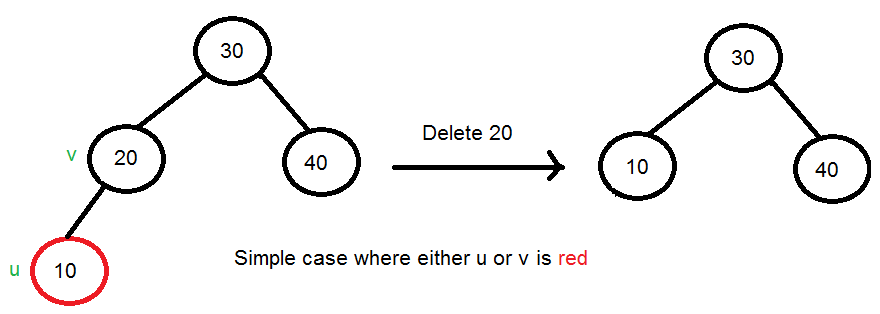 3) If Both u and v are Black.
3.1) Color u as double black. Now our task reduces to convert this double black to single black. Note that If v is leaf, then u is NULL and color of NULL is considered as black. So the deletion of a black leaf also causes a double black.
3.2) Do following while the current node u is double black and it is not root. Let sibling of node be s.
3) If Both u and v are Black.
3.1) Color u as double black. Now our task reduces to convert this double black to single black. Note that If v is leaf, then u is NULL and color of NULL is considered as black. So the deletion of a black leaf also causes a double black.
3.2) Do following while the current node u is double black and it is not root. Let sibling of node be s.
(a) If sibling s is black and at least one of sibling’s children is red, perform rotation(s). Let the red child of s be r. This case can be divided in four subcases depending upon positions of s and r.
(i) Left Left Case (s is left child of its parent and r is left child of s or both children of s are red). This is mirror of right right case shown in below diagram.
(ii) Left Right Case (s is left child of its parent and r is right child). This is mirror of right left case shown in below diagram.
(iii) Right Right Case (s is right child of its parent and r is right child of s or both children of s are red)
 (b) If sibling is black and its both children are black, perform recoloring, and recur for the parent if parent is black.
(b) If sibling is black and its both children are black, perform recoloring, and recur for the parent if parent is black.

In this case, if parent was red, then we didn’t need to recur for prent, we can simply make it black (red + double black = single black)
(c) If sibling is red, perform a rotation to move old sibling up, recolor the old sibling and parent. The new sibling is always black (See the below diagram). This mainly converts the tree to black sibling case (by rotation) and leads to case (a) or (b). This case can be divided in two subcases.
(i) Left Case (s is left child of its parent). This is mirror of right right case shown in below diagram. We right rotate the parent p.
(iii) Right Case (s is right child of its parent). We left rotate the parent p.

Heap
Heap adalah suatu Binary Tree lengkap yang menggunakan persyaratan Heap. Di dalam heap terdapat dua tipe heap yaitu Min Heap dan Max Heap. Min Heap adalah sebuah Binary Tree dimana root dari tree tersebut adalah angka terkecil atau memiliki nilai terkecil dibandingkan seluruh node didalam tree tersebut sedangkan Max Heap adalah sebaliknya yaitu Binary Tree dimana root dari tree tersebut adalah angka terbesar dari tree tersebut.
Min Heap
Aturan dalam membuat Min Heap:
1. Value dari suatu parent harus lebih kecil dari value anaknya
2. Root dari tree adalah value terkecil yang ada didalam tree
3. Value terbesar terdapat di salah satu node leaf
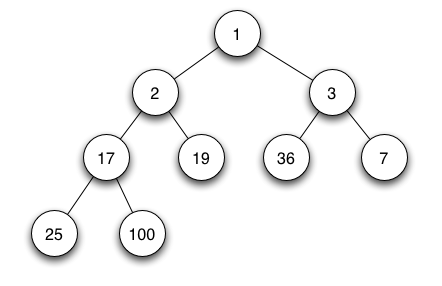
Max Heap
Aturan dalam membuat Max Heap:
1. Value dari suatu parent harus lebih besar dari value anaknya
2. Root dari tree adalah value terbesar yang ada didalam tree
3. Value terkecil terdapat di salah satu node leaf
Min-Max Heap
Min-Max Heap adalah gabungan dari Min Heap dan Max Heap. Karena Min-Max Heap adalah gabungan dari Min dan Max Heap maka aturan dari kedua heap tersebut disatukan menjadi seperti berikut:
1. Root menggunakan aturan Min Heap.
2. Setiap node yang memiliki height ganjil mengikuti aturan Min Heap.
3. Setiap node yang memiliki height genap mengkuti atuan Max Heap.
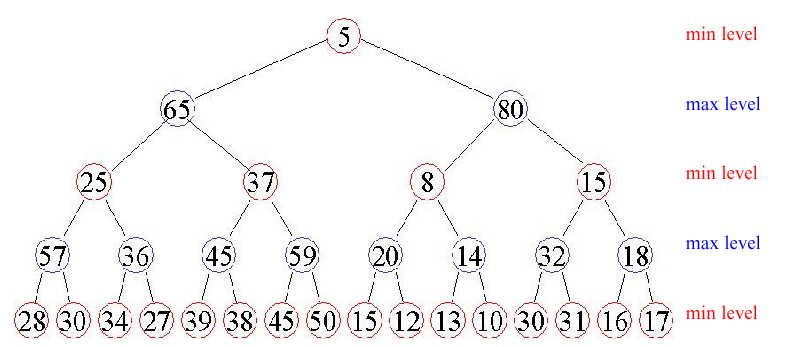 Tries
Tries adalah Binary Tree dimana isi dari tersebut adalah kumpulan dari kata-kata. Tree ini dibuat untuk mempermudah pencarian suatu kata-kata (biasanya digunakan pada saat pembuatan fitur search pada kamus).
Tries
Tries adalah Binary Tree dimana isi dari tersebut adalah kumpulan dari kata-kata. Tree ini dibuat untuk mempermudah pencarian suatu kata-kata (biasanya digunakan pada saat pembuatan fitur search pada kamus).
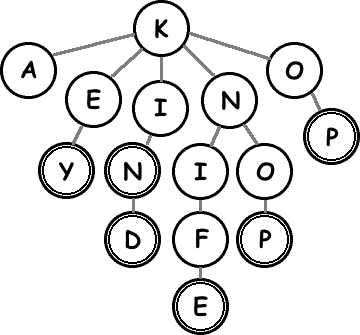
Insertion Vs Deletion:
Like Insertion, recoloring and rotations are used to maintain the Red-Black properties.
Like Insertion, recoloring and rotations are used to maintain the Red-Black properties.
In insert operation, we check color of uncle to decide the appropriate case. In delete operation, we check color of sibling to decide the appropriate case.
The main property that violates after insertion is two consecutive reds. In delete, the main violated property is, change of black height in subtrees as deletion of a black node may cause reduced black height in one root to leaf path.
Deletion is fairly complex process. To understand deletion, notion of double black is used. When a black node is deleted and replaced by a black child, the child is marked as double black. The main task now becomes to convert this double black to single black.
Deletion Steps
Following are detailed steps for deletion.
Following are detailed steps for deletion.
1) Perform standard BST delete. When we perform standard delete operation in BST, we always end up deleting a node which is either leaf or has only one child (For an internal node, we copy the successor and then recursively call delete for successor, successor is always a leaf node or a node with one child). So we only need to handle cases where a node is leaf or has one child. Let v be the node to be deleted and u be the child that replaces v (Note that u is NULL when v is a leaf and color of NULL is considered as Black).
2) Simple Case: If either u or v is red, we mark the replaced child as black (No change in black height). Note that both u and v cannot be red as v is parent of u and two consecutive reds are not allowed in red-black tree.


3) If Both u and v are Black.
3.1) Color u as double black. Now our task reduces to convert this double black to single black. Note that If v is leaf, then u is NULL and color of NULL is considered as black. So the deletion of a black leaf also causes a double black.
3.2) Do following while the current node u is double black and it is not root. Let sibling of node be s.
(a) If sibling s is black and at least one of sibling’s children is red, perform rotation(s). Let the red child of s be r. This case can be divided in four subcases depending upon positions of s and r.
(a) If sibling s is black and at least one of sibling’s children is red, perform rotation(s). Let the red child of s be r. This case can be divided in four subcases depending upon positions of s and r.
(i) Left Left Case (s is left child of its parent and r is left child of s or both children of s are red). This is mirror of right right case shown in below diagram.
(ii) Left Right Case (s is left child of its parent and r is right child). This is mirror of right left case shown in below diagram.
(iii) Right Right Case (s is right child of its parent and r is right child of s or both children of s are red)


(b) If sibling is black and its both children are black, perform recoloring, and recur for the parent if parent is black.

In this case, if parent was red, then we didn’t need to recur for prent, we can simply make it black (red + double black = single black)

In this case, if parent was red, then we didn’t need to recur for prent, we can simply make it black (red + double black = single black)
(c) If sibling is red, perform a rotation to move old sibling up, recolor the old sibling and parent. The new sibling is always black (See the below diagram). This mainly converts the tree to black sibling case (by rotation) and leads to case (a) or (b). This case can be divided in two subcases.
(i) Left Case (s is left child of its parent). This is mirror of right right case shown in below diagram. We right rotate the parent p.
(iii) Right Case (s is right child of its parent). We left rotate the parent p.

(i) Left Case (s is left child of its parent). This is mirror of right right case shown in below diagram. We right rotate the parent p.
(iii) Right Case (s is right child of its parent). We left rotate the parent p.

Heap
Heap adalah suatu Binary Tree lengkap yang menggunakan persyaratan Heap. Di dalam heap terdapat dua tipe heap yaitu Min Heap dan Max Heap. Min Heap adalah sebuah Binary Tree dimana root dari tree tersebut adalah angka terkecil atau memiliki nilai terkecil dibandingkan seluruh node didalam tree tersebut sedangkan Max Heap adalah sebaliknya yaitu Binary Tree dimana root dari tree tersebut adalah angka terbesar dari tree tersebut.
Min Heap
Aturan dalam membuat Min Heap:
1. Value dari suatu parent harus lebih kecil dari value anaknya
2. Root dari tree adalah value terkecil yang ada didalam tree
3. Value terbesar terdapat di salah satu node leaf

Max Heap
Aturan dalam membuat Max Heap:
1. Value dari suatu parent harus lebih besar dari value anaknya
2. Root dari tree adalah value terbesar yang ada didalam tree
3. Value terkecil terdapat di salah satu node leaf
Min Heap
Aturan dalam membuat Min Heap:
1. Value dari suatu parent harus lebih kecil dari value anaknya
2. Root dari tree adalah value terkecil yang ada didalam tree
3. Value terbesar terdapat di salah satu node leaf

Max Heap
Aturan dalam membuat Max Heap:
1. Value dari suatu parent harus lebih besar dari value anaknya
2. Root dari tree adalah value terbesar yang ada didalam tree
3. Value terkecil terdapat di salah satu node leaf
Min-Max Heap
Min-Max Heap adalah gabungan dari Min Heap dan Max Heap. Karena Min-Max Heap adalah gabungan dari Min dan Max Heap maka aturan dari kedua heap tersebut disatukan menjadi seperti berikut:
1. Root menggunakan aturan Min Heap.
2. Setiap node yang memiliki height ganjil mengikuti aturan Min Heap.
3. Setiap node yang memiliki height genap mengkuti atuan Max Heap.

Tries
Tries adalah Binary Tree dimana isi dari tersebut adalah kumpulan dari kata-kata. Tree ini dibuat untuk mempermudah pencarian suatu kata-kata (biasanya digunakan pada saat pembuatan fitur search pada kamus).
